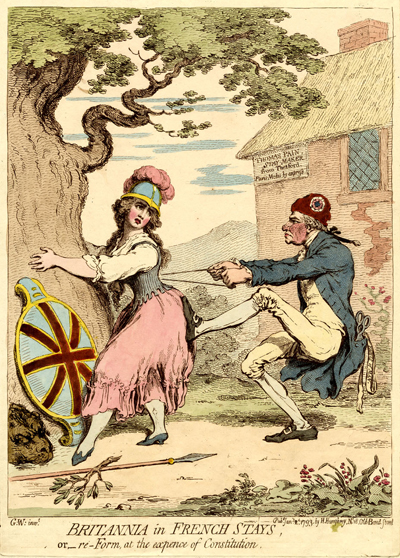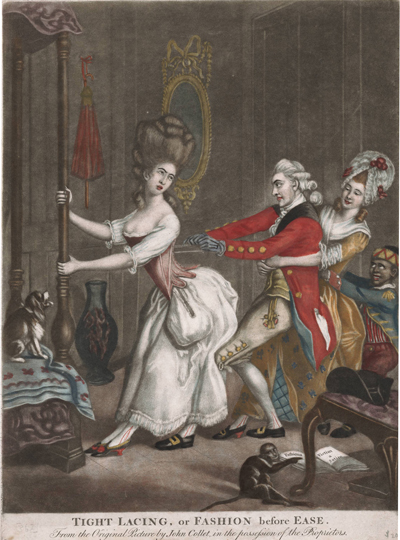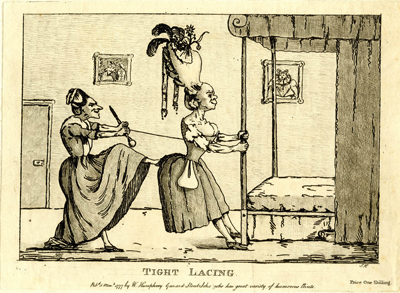Britannia in French Stays. . .
Britannia in French Stays, or Re-Form, at the Expence of Constitution is one of two prints with different titles using the same image published by Gillray on January 2, 1793. The other is Fashion Before Ease, or a Good Constitution Sacrificed for a Fantastick Form. Both titles play upon the political and physical meanings of "constitution" and "form".

© Trustees of the British Museum
Thomas Paine, author of the influential The Rights of Man is shown forcibly tightening the laces on Britannia's stay or corset, presumably to give her form a more French Parisian style. (He wears the revolutionary bonnet rouge and tricolor cockade.) Before Paine became a political pamphleteer, he was reputed to be apprenticed as a stay maker in his father's shop in Thetford as the sign behind him suggests. The alternate spelling of Paine's name on the sign may be another pun, pointing to the discomfort already being endured as Paine tries to re-shape Britannia in the French mode.
The English and French constitutions had been a frequent topic of discussion since 1790 when Burke wrote his Reflections on the Revolution in France and Paine replied in his The Rights of Man the next year. Paine had argued that Britain could benefit from from reforming the British constitution in ways similar to those in France and America.
There are two possible "sources" for Gillray's design. The first was noted by M. Dorothy George: Tight Lacing, or Fashion Before Ease a mezzotint based on a John Collett painting of 1777. Britannia looks back over her left shoulder at Paine much as the young lady does in the Collett mezzotint. The gentlemen in both prints are pulling hard on the laces of her corset. And Gillray clearly borrows Collett's subtitle, "Fashion Before Ease," for the title of at least one of the two versions of this print.

Tight Lacing, or Fashion Before Ease [1777]
© Lewis Walpole Library, Yale University
But there is another, possibly earlier, print that Gillray may have seen that served as a model or source. Published by William Humphrey while Gillray was creating other prints for him in January 1777, it is called simply Tight Lacing. It shows an ugly woman, feet planted next to one another, holding on to the bedpost much as the beautiful young woman in the Collett print does. Her maid, however, plants her left foot on the lady's bottom the better to pull harder as Paine does in Gillray's print. Tight Lacing is signed with the monogram RS which Dorothy George elsewhere attributes to Richard Sneer, a pseudonym for Richard Brinsley Sheridan. But it is not unlikely that Tight Lacing is, in fact, an early print by Gillray himself, like The Captain's So Kind (1777) imitating some of the mannerisms of RS.

Tight Lacing [1777]
© Trustees of the British Museum
Gillray created at least two other prints in which Paine was featured: The Rights of Man. . . (1791) and Tom Paine's Nightly Pest (1792). But Fashion Before Ease . . . is the first one, to provide a credible likeness of Paine himself. Since the portrait of Paine most resembles the 1793 William Sharp engraving based on a 1792 George Romney painting, it is likely that Gillray saw the painting in Sharp's studio while Sharp was working on the engraving.

Thomas Paine [1793]
© National Portrait Gallery, London
Sources and Reading
- Commentary from the British Museum on Britannia in French Stays. . .
- Draper Hill, Fashionable Contrasts, 1966, #7
- "Thomas Paine," Wikipedia
Comments & Corrections
NOTE: Comments and/or corrections are always appreciated. To make that easier, I have included a form below that you can use. I promise never to share any of the info provided without your express permission.